This post contains affiliate links, which means I may earn a commission if you purchase through those links (at no extra cost to you).
For the best, most delicious homemade Chicken Broth recipe, start with a whole raw chicken or chicken pieces and simple vegetables and herbs. At the end of it, you’ll have 4 cups of delicious cooked chicken and 2 quarts of the best chicken broth you’ve ever tasted. Freeze it for your future soups, stews, and casseroles.
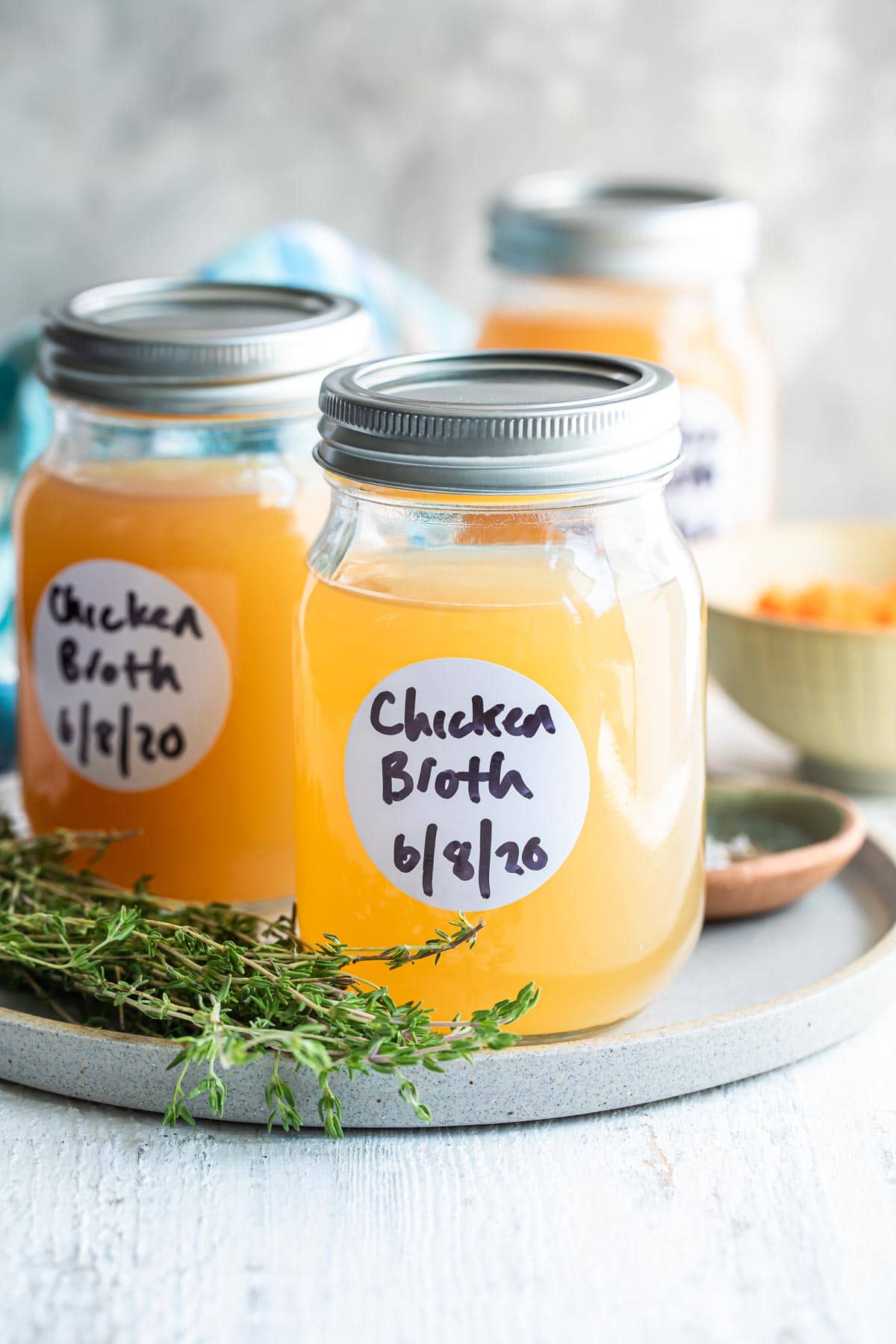
One of life’s simple pleasures is poaching a whole chicken. Here we do it to make homemade broth, but you can also do it to make chicken – and either way, you get both!
In my opinion, this is a fun, relaxing Sunday ritual that more people should try. We are always so busy on the weekends, and poaching a chicken forces you to press pause. It’s fulfilling to create with your hands, so enjoy the moments you chop your veggies and pull spices off their sprigs. You are creating something.
At the end, you’ll have big batch of broth that’s perfect for soups, sauces, and even gravy. And of course, you’ll have the chicken. It’s perfect in Chicken Tinga, Chicken Salad, or in a chicken soup recipe. Whether it’s Chicken Noodle Soup with chunks of tender chicken or creamy Chicken Soup with Wild Rice, nothing beats this cozy bowl of homemade comfort.
Recipe ingredients
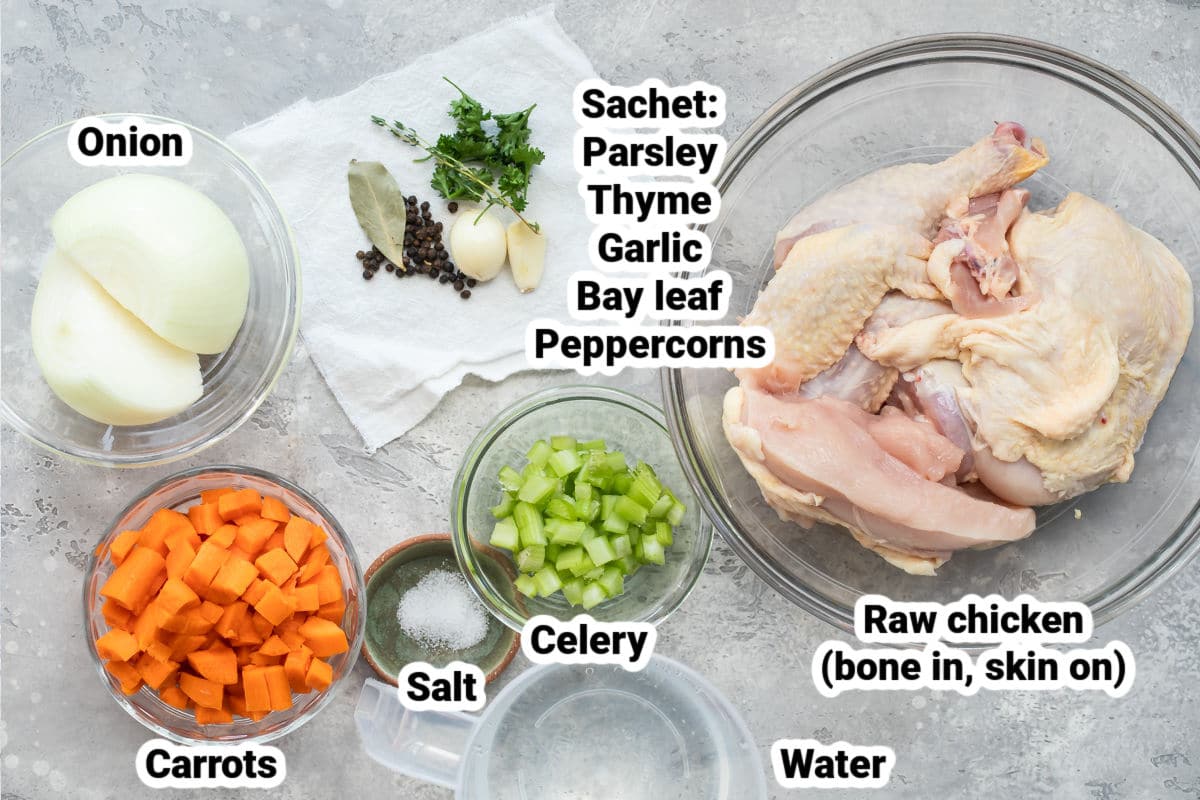
At a Glance: Here is a quick snapshot of what ingredients are in this recipe.
Please see the recipe card below for specific quantities.
Ingredient notes
- Chicken: This recipe uses a whole raw chicken or the equivalent of cut-up pieces (you can do 4 to 5 pounds of bone-in, skin-on chicken breast, thighs, drumsticks, necks, wings, whatever!).
- Organ meats: The heart and gizzard can be added to the broth if desired, but the liver should be discarded or reserved for another purpose.
- Cold water: Always start with cold water. This helps keep the broth clear, not cloudy. The amount of water used and the length of simmering time will determine the intensity of the broth.
- Vegetables: Some cooks save old vegetable trimmings to add to their broth. I prefer to start with new, fresh vegetables because I think the broth will taste better. So yes, we peel the carrots, and save your vegetable scraps for composting!
- Herbs and spices: A sachet is a fancy term for parsley stems, thyme, bay leaves, peppercorns, and optionally, garlic or cloves, tied up in a piece of cheesecloth with twine. You could also use a tea ball or loose-leaf tea bag to hold them. It makes it easier to pull these small ingredients out of the broth later. Or, you can just add everything straight to the pot since you strain the broth at the end.
Step-by-step instructions
- To a Dutch oven or large stock pot, add chicken and cold water to cover (see note 3). Over medium-high heat, bring to a boil. Immediately reduce heat to low and skim the foam off the top of the liquid with a spoon.
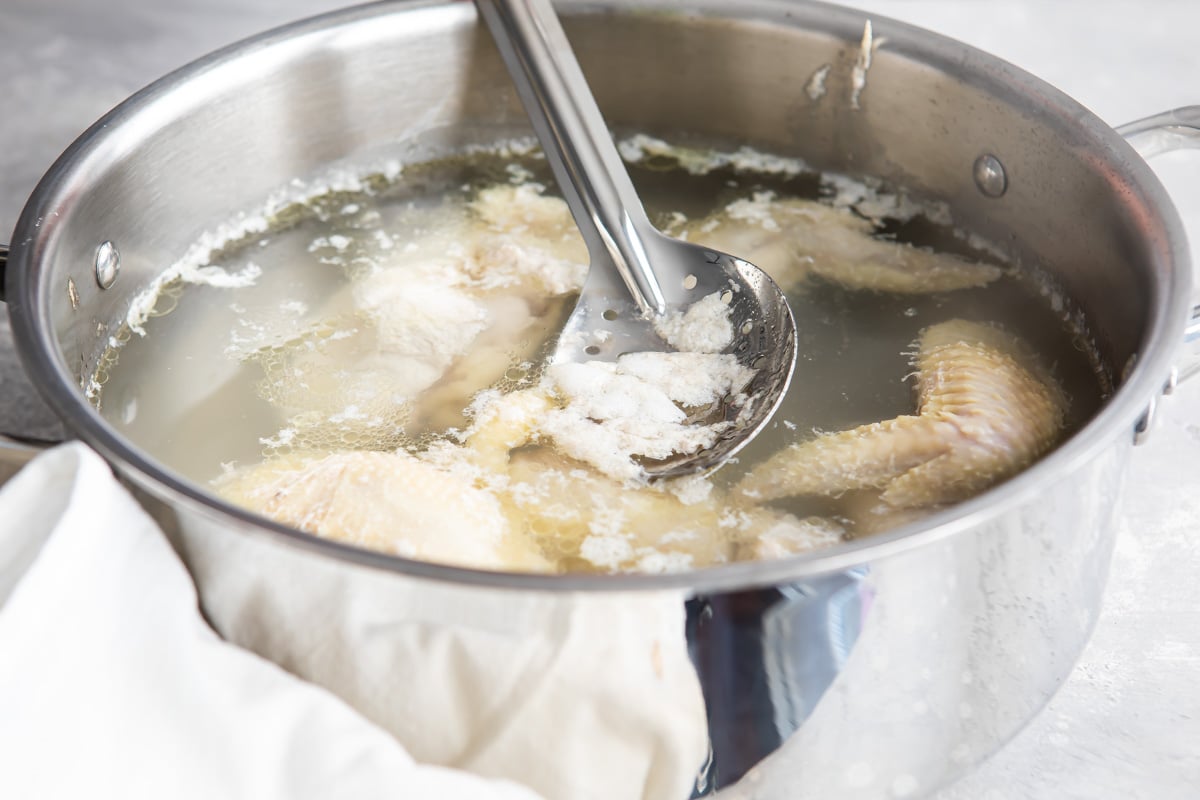
- To the pot add onion, carrot, celery, and salt. If desired, tie parsley stems, thyme, garlic, bay leaf, and peppercorns to make a sachet or add loosely to the pot.
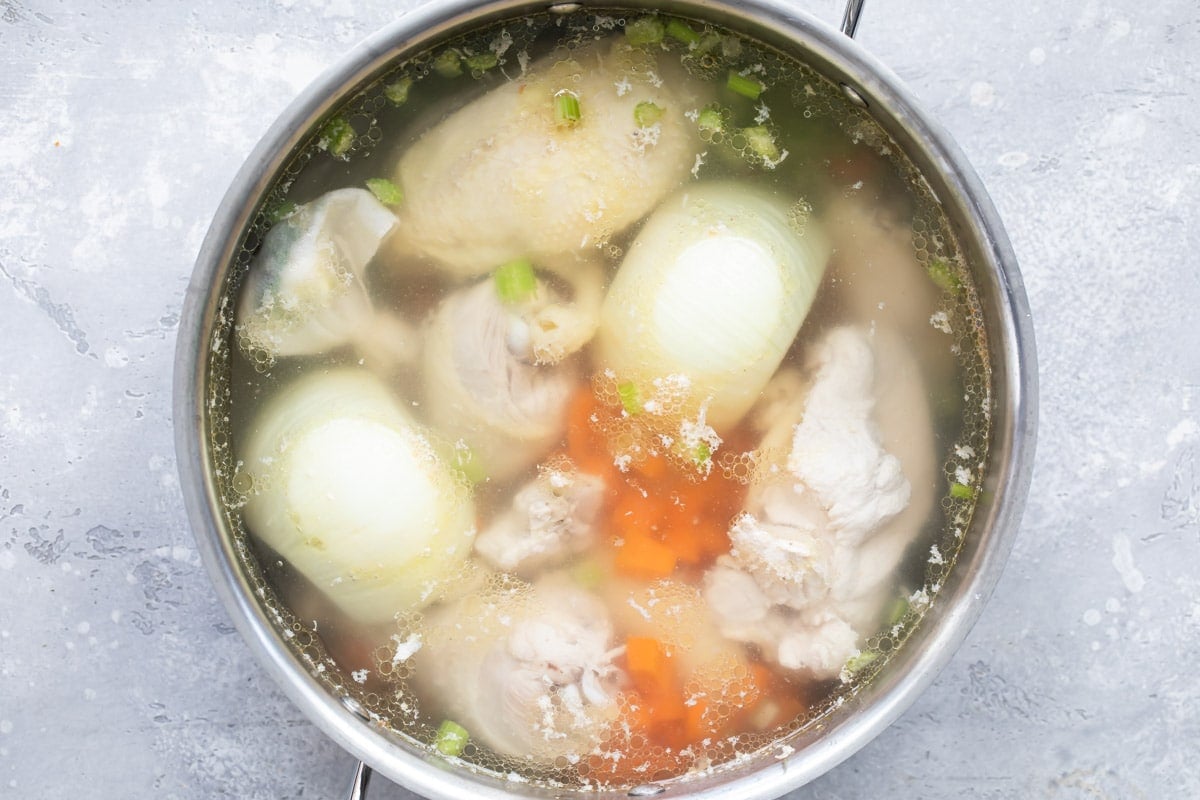
- Simmer gently (bubbles should barely break the surface at irregular intervals) until the chicken is cooked through, at least 1 hour or up to 5 hours. The longer the broth simmers, the more flavor it will have. (NOTE: After 1 hour, you should remove the chicken breasts from the pot to prevent them from drying out).
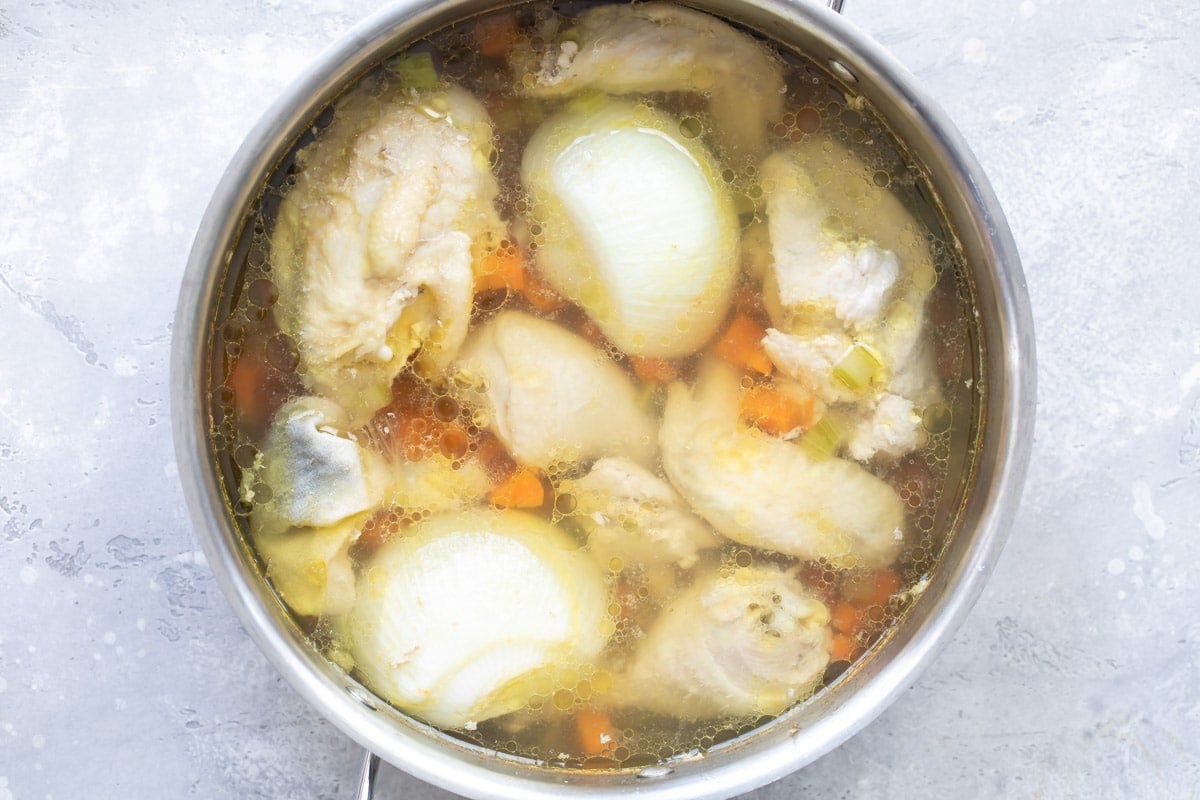
- Remove chicken from pan to a rimmed baking sheet or large bowl. Separate chicken, discarding skin and bones (you should have about 4 cups chicken).
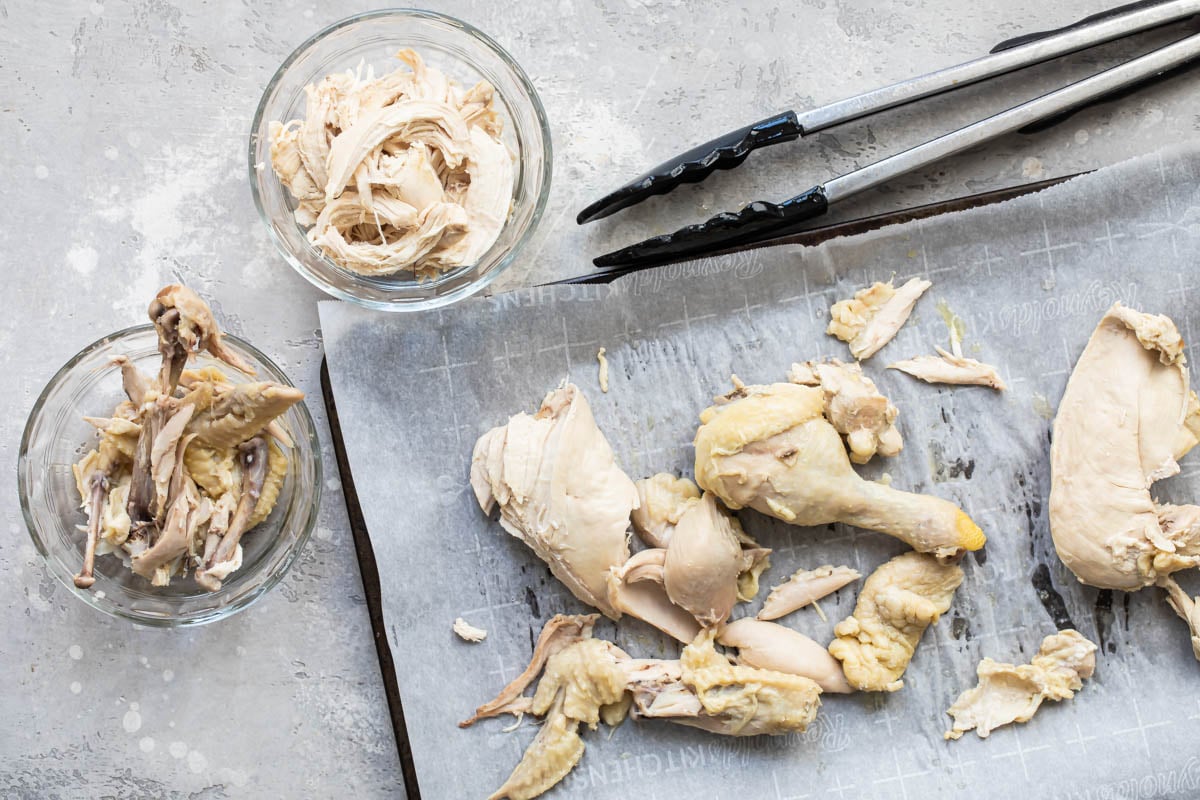
- Strain the broth through a fine-mesh sieve or cheesecloth. Place in a large bowl and chill covered overnight in the refrigerator.
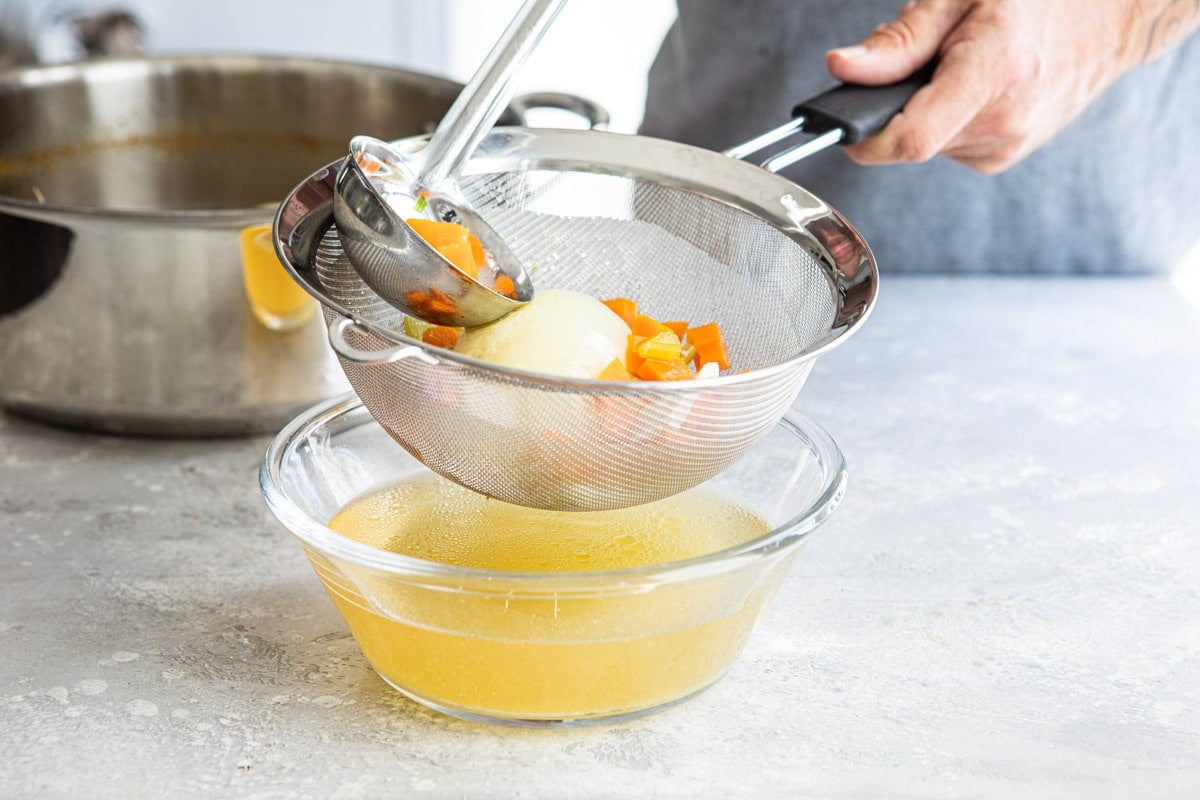
- The next day, scrape off the accumulated fat from the top of the stock and discard. Divide the broth into freezer-safe containers (leaving at least 1/2-inch for expansion), label, and freeze. Or, refrigerate and use within 4 days.
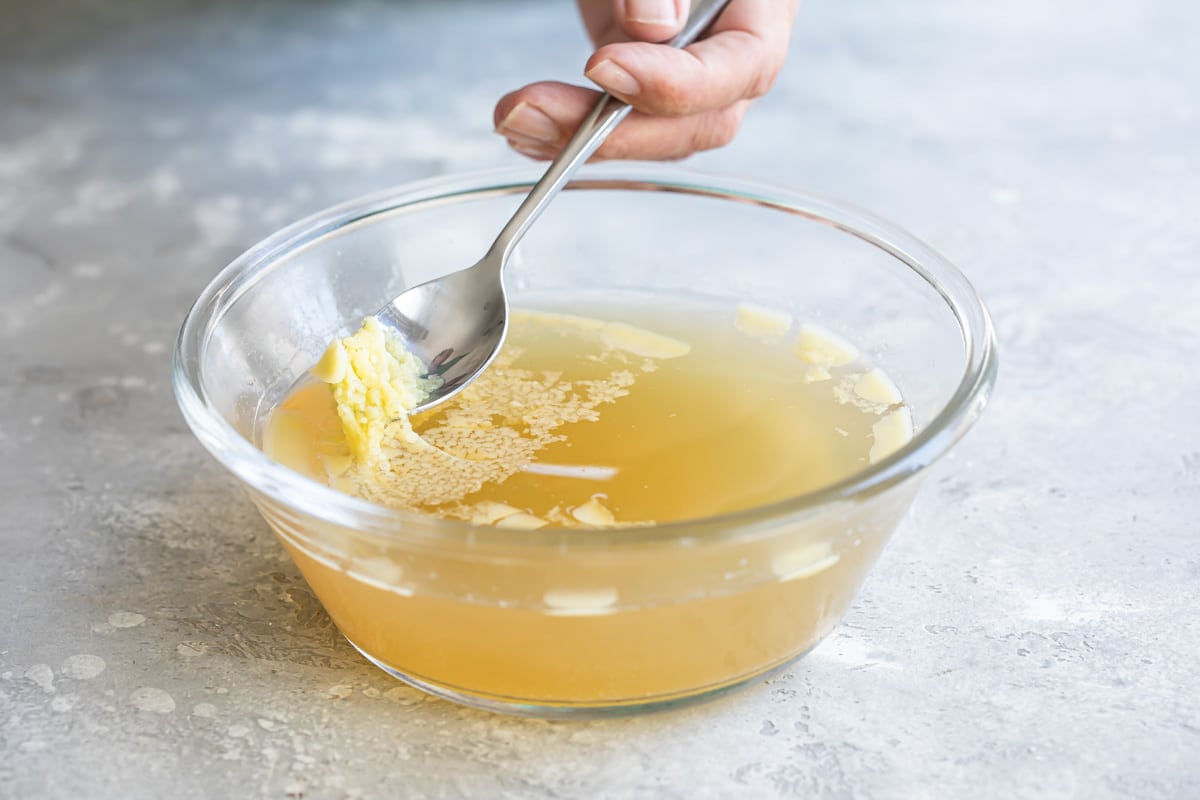
Recipe tips and variations
- Yield: This recipe makes about 8 cups (2 quarts) homemade chicken broth. You’ll also get 4 cups cooked chicken in the process.
- Refrigerate: Store chicken broth in the refrigerator and use within 4 days.
- Freezer: Divide the broth into freezer-safe containers (I like to use 16-ounce glass jars, but freezer bags work too) and leave 1/2-inch head space for expansion. Label and date, then freeze for up to 3 months. Thaw overnight in the refrigerator.
- Leftover roasted chicken carcass: To make chicken broth from a roasted chicken, I recommend adding the leftover roast chicken carcass to a pot with raw chicken. If you boil just a leftover roasted chicken carcass on its own, the broth will be thin and lack body and flavor.
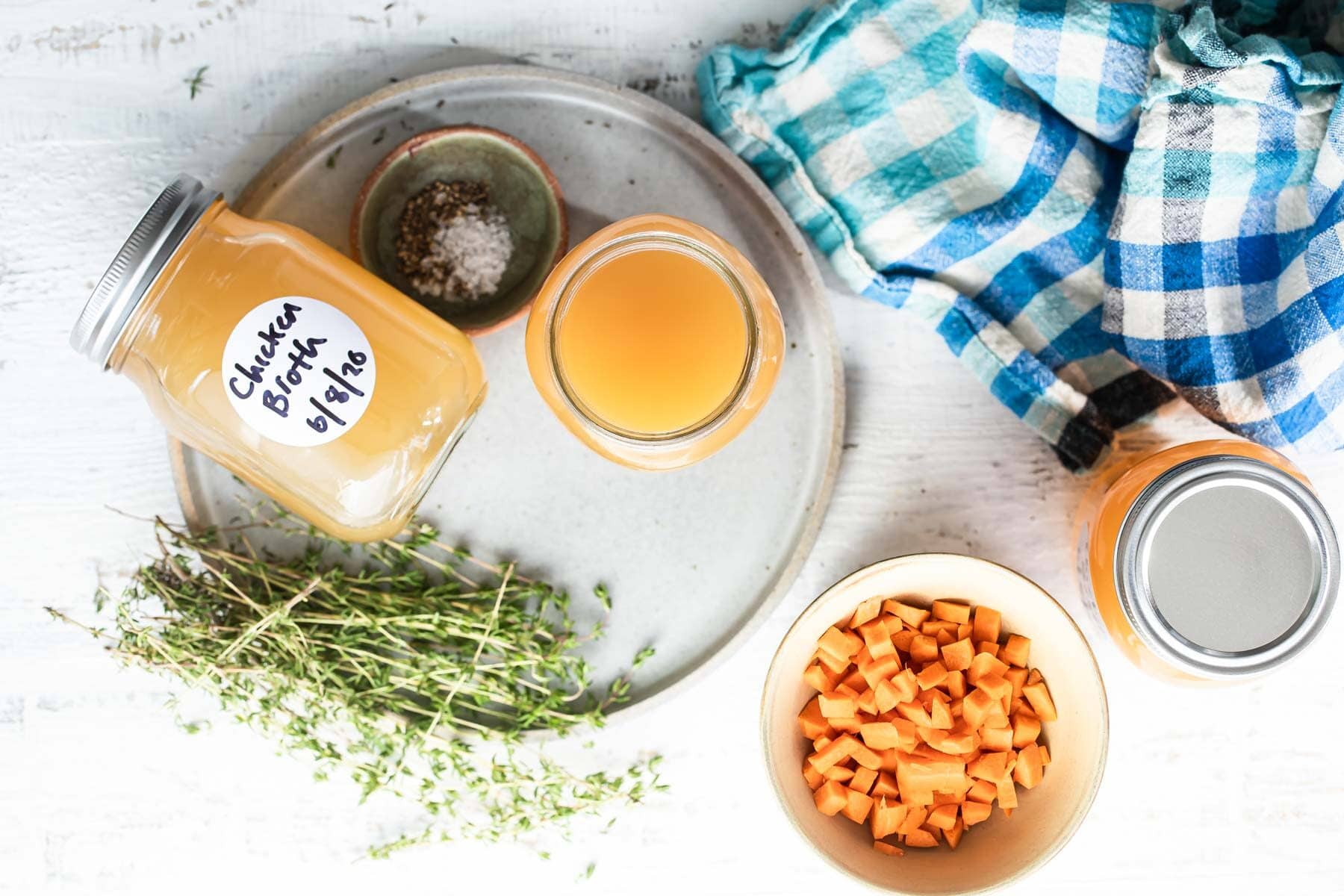
Frequently Asked Questions
Technically, stock is made with just bones, while broth is made with bones and meat.
You can flavor your broth with vegetables, herbs, and spices. If you don’t have much time or patience, add just a clove of garlic, a sliver of onion, and salt.
Yes, absolutely! Plain chicken broth is an absolutely delicious drink. If you want to spruce up your cup of cozy broth, try hot sauce, fresh lemon juice, and some fresh cilantro sprigs.
If your recipe calls for chicken broth, it’s looking for that extra savory flavor. You could substitute bouillon paste or cubes which will give you the same effect. But in some cases, depending on the recipe, you don’t absolutely need chicken broth and could just substitute water. But, you’ll lose flavor that way. It just depends on what you are cooking.
Put your chicken broth to work
Stews and Soups
Mexican Chicken Soup
Italian Recipes
Italian Wedding Soup
Stews and Soups
Chicken Ramen
Stews and Soups
Ham and Bean Soup Recipe
More From Culinary Hill
Join Us

How to Make Chicken Broth
Equipment
- Mason jars (I love storing my leftovers in them)
Ingredients
- 1 4- to 5-pound whole chicken cut into pieces and giblets removed (see note 1 & 2)
- Cold water about 12 cups (see note 3)
- 1 medium onion peeled and halved
- 1 large carrot peeled and coarsely chopped, or 2 medium carrots (see note 4)
- 1 celery rib coarsely chopped
- 1 tablespoon salt
Sachet (see note 5):
- 6 fresh parsley stems
- 1 sprig fresh thyme
- 2 cloves garlic
- 1 bay leaf
- 1 teaspoon whole black peppercorns
Instructions
- To a Dutch oven or large stock pot, add chicken and cold water to cover (see note 3).
- Over medium-high heat, bring to a boil. Immediately reduce heat to low and skim the foam off the top.
- To the pot add onion, carrot, celery, and salt. If desired, tie parsley stems, thyme, garlic, bay leaf, and peppercorns to make a sachet or add loosely to the pot (see note 5).
- Simmer gently (bubbles should barely break the surface at irregular intervals) until the chicken is cooked through, at least 1 hour or up to 5 hours. The longer the broth simmers, the more flavor it will have. (NOTE: After 1 hour, you should remove the chicken breasts from the pot to prevent them from drying out).
- Remove chicken from pot to a rimmed baking sheet or large bowl. Separate chicken, discarding skin and bones (you should have about 4 cups chicken).
- Strain the broth through a fine-mesh strainer or cheesecloth. Place in a large bowl and chill covered overnight in the refrigerator.
- The next day, scrape off the accumulated fat from the top of the stock and discard. Divide the broth into freezer-safe containers (leaving at least 1/2-inch for expansion), label, and freeze. Or, refrigerate and use within 4 days.
Recipe Video
Notes
- Chicken: This recipe uses a whole raw chicken or the equivalent of cut-up pieces (you can do 4 to 5 pounds of bone-in, skin-on chicken breast, thighs, drumsticks, necks, whatever!).
- Organ meats: The heart and gizzard can be added to the broth if desired, but the liver should be discarded or reserved for another purpose.
- Cold water: Always start with cold water. This helps keep the broth clear, not cloudy. The amount of water used and the length of simmering time will determine the intensity of the broth.
- Vegetables: Some cooks save old vegetable trimmings to add to their broth. I prefer to start with new, fresh vegetables because I think the broth will taste better. So yes, we peel the carrots, and save your vegetable scraps for composting!
- Herbs and spices: A sachet is a fancy term for parsley stems, thyme, bay leaves, peppercorns, and optionally, garlic or cloves, tied up in a piece of cheesecloth with twine. You could also use a tea ball or loose leaf tea bag to hold them. It makes it easier to pull these small ingredients out of the broth later. Or, you can just add everything straight to the pot since you strain the broth at the end.
- Yield: This recipe makes about 8 cups (2 quarts) homemade chicken broth. You’ll also get 4 cups cooked chicken in the process.
- Storage: Store chicken broth in the refrigerator and use within 4 days.

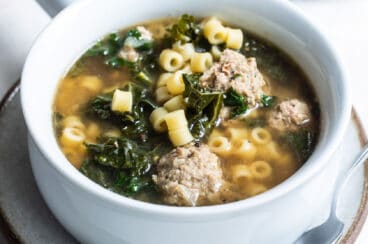

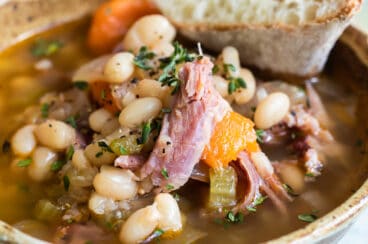
This was delicious! I will use this recipe from now on. Now I need a receipt for chicken croquettes for some of the leftover chicken please give me one
Hi Pam, I’m so glad you loved this broth! I love your idea! Adding it to my list! Thank you and take care! – Meggan
I haven’t tried the recipe yet but felt compelled to mention the confusion over the final yield. 8 cups of stock is 2 quarts so yes Meggan, you are correct with that. But what you are not seeing is that your “Yield” section under your final notes states you get 4 cups (2 quarts) chicken stock. 4 cups is only 1 quart. Something needs to be corrected.
Hi Debbie, thank you for noticing that small error on note 6 in the recipe card. I’ve corrected it, and I hope you love this recipe! Take care and thank you again for taking the time to let me know about this so I can correct it. The final yield is about 8 cups of broth and 4 cups of cooked chicken. Hope this clears it up! – Meggan
4 cups is one quart, not two quarts.
Hi Barb, this recipe makes 4 cups cooked chicken and 2 quarts (8 cups) of the best chicken broth. – Meggan
I’m going to try it today. Hope for the best.
Can I essentially just make chicken noodle soup using this recipe? As in pull the chicken out once it’s cooked, shred it up and throw it back in the broth, leaving the vegetables and adding some noodles?
Hi Log, I don’t see why not! Hope you enjoy. – Meggan
4 cups is two pints or one quart.
Can you start with a whole frozen chicken?
Hi Joan, yes! If you can, I would suggest using a big enough pot so the entire chicken can be submerged. It will also take longer so be sure to check your chicken temps and make sure the thickest parts hit 165 degrees. Hope you enjoy! – Meggan
Is one celery ribs, just one piece off the bunch or the entire bunch?
Hi Diana, one celery rib is one piece off the whole bunch. Thank you! 🙂 -Meggan
Heya i am for the first time here. I followed your instructions and it was perfect.
This seems super easy! I’m going to try it today.